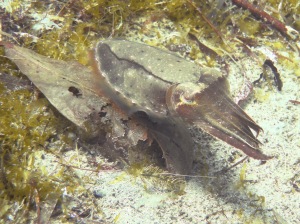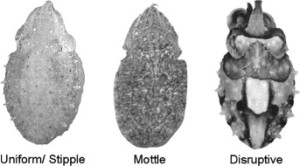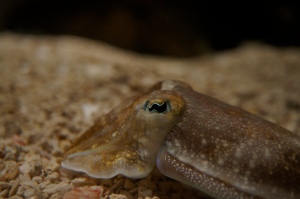By Jocelyn Brown, John Lee, & Janine Mistrick
Despite their name, cuttlefish are not fish or even vertebrates. They are mollusks and more specifically cephalopods, being closely related to squid and octopus. They derive their name from the cuttlebone, which is a hard, internal shell primarily composed of aragonite and utilized for buoyancy control. Belonging to the order Sepiida, cuttlefish possess the general cephalopod body plan with the head and mantle forming a single unit from which eight arms and two sucker-covered tentacles are attached.
Cuttlefish range across much of the Old World from the Western and South Pacific to the coasts of Africa to the Mediterranean and North Seas. They are mostly warm water species, living in shallow habitats near the coast. These animals generally range in size from 15 to 25 cm while the largest species can grow to 50 cm. The life expectancy of cuttlefish is from one to two years in the wild (Norman 2000; Reid 2006; Roper 1984).

A cuttlefish uses a variety of colors and patterns to camouflage with a leaf below it on the seafloor.
Cuttlefish are most famous for their ability to change their skin color in mere seconds. Even more so than other closely-related cephalopods, cuttlefish use color and pattern changes to communicate with other cuttlefish, to camouflage themselves when in danger, and to frighten off potential predators (Norman 2000; Reid 2006; Roper 1984; Shohet 2006).
When cuttlefish are camouflaging with their environment, substrate contrast and particle size are the two main factors that cuttlefish use to adjust their body pattern to display a wide array of patterns from uniform/stipple, to mottle, to disruptive (Barbosa et al 2008 – Cuttlefish Camouflage).

Examples of three general camouflage patterns expressed by cuttlefish are shown: uniform/stipple, mottle, and disruptive.
Uniform/stipple and mottle body coloration are two camouflage patterns commonly used by cuttlefish. These two patterns can be generally grouped under the term “background matching” (Buresch 2011).
Uniform coloration involves minimal or no contrast variation in skin color. Uniform coloration is used when cuttlefish camouflage with open, uniform sand or uniformly colored rocks or when they are hiding in the shadows. Stipple patterns are often considered to be a subset of uniform patterning. Stipple patterning is characterized by a uniform distribution of small, rounded spots. This pattern represents a transition phase from uniform to mottle patterns.

A cuttlefish uses a uniform/stipple pattern in a similar shade of beige to blend in with the sand in its environment.
Mottle coloration is defined as small-to-moderate-scale light and dark splotches distributed fairly evenly and repeatedly across the body. Low-to-moderate contrast between the light and dark patches characterizes this pattern (Hanlon et al 2009).
The pattern cuttlefish choose to display generally matches the pattern and contrast of the substrate it is attempting to camouflage with. Often, a general background match is chosen and the cuttlefish will change its body color and pattern to generally resemble the contrast, texture, intensity, and color of the substrate but the exact pattern will not match the immediate background (Hanlon et al 2009).
Cuttlefish: Chameleons of the Sea
The more contrast present in the background, the higher the intensity of the camouflage pattern the cuttlefish will display (Hanlon et al 2009). High-contrast substrates often evoke another type of camouflage patterning called disruptive patterning.
Disruptive patterning is a type of camouflage which is characterized by high-contrast light and dark patches in a random orientation that might also disrupt the organisms shape and orientation. Examples of this can be seen everywhere, even in human behavior, in which soldiers wear camouflage in order to hide themselves from enemies.

Stark contrast is seen in this cuttlefish as it uses a disruptive color pattern to break up its outline as viewed by overhead predators.
The cuttlefish however, are experts in disruptive patterning and are able to make themselves appear invisible to both predators and prey in a hundredth of a second! They are able to make such instantaneous changes in their appearance by using their neurally controlled chromatophore system in their skin. Chromatophores contain their pigments in a cytoelastic sac. Cuttlefish are able to change color by making the cytoelastic sac bigger or smaller and by distorting the cytoelastic sac’s shape. (Cloney 1968)
Cuttlefish use disruptive components typically for blending in with larger particles and objects, rather that fine gravel. Additionally, this camouflage mechanism is used when the edges of the background are clear and discrete. Other factors that signal for disruptive patterning are the visual depth of the object, as well as brightness of the background. There continues to be a lot of stipulation on the mechanisms of disruptive patterning in cuttlefish due to its complexity and nearly instantaneous transformation.

A cuttlefish uses a uniform/stipple pattern in a similar shade of beige to blend in with the sand in its environment.
The cuttlefish has a highly evolved system of skin coloration that it uses for camouflage and display. Being able to blend into a variety of environments, a camouflaged cuttlefish is often indistinguishable from animals of the same species. You could say that cuttlefish are truly nature’s masters of disguise!
Can Cuttlefish camouflage in a living room? – Richard Hammond’s Miracles of Nature – BBC One
MEDIA REFERENCES
Barbosa, A. et al. Cuttlefish camouflage: The effects of substrate contrast and size in evoking uniform, mottle or disruptive body patterns. Vision Research 48, 1242–1253 (2008).
Can Cuttlefish Camouflage in a Living Room? – Richard Hammond’s Miracles of Nature – BBC One. YouTube. BBC, 23 Nov. 2012. Web. <https://www.youtube.com/watch?v=pgDE2DOICuc>.
Cuttlefish: Chameleons of the Sea. YouTube. Discovery, 11 May 2010. Web. <https://www.youtube.com/watch?v=WqMNjUp6UeA>.
Dachalan. “Cuttlefish.” Flickr.com. Flickr, a Yahoo Company, 9 April 2007. Web. 15 April 2015.
Dachalan. “Cuttlefish.” Flickr.com. Flickr, a Yahoo Company, 10 April 2008. Web. 15 April 2015.
Simmons, Charlene N. “Cuttlefish.” Photograph. Flickr.com. Flickr, a Yahoo Company, 3 June 2014. Web. 15 April 2015.
Stiefel, Klaus. “Cuttlefish.” Flickr.com. Flickr, a Yahoo Company, 5 November 2011. Web. 15 April 2015.
World’s Deadliest – “Sudden Death” Cuttlefish. YouTube. NatGeoWild, 1 Apr. 2013. Web. <https://www.youtube.com/watch?v=E-zodF-XrSE>.
TEXT REFERENCES
Barbosa, A. et al. Cuttlefish camouflage: The effects of substrate contrast and size in evoking uniform, mottle or disruptive body patterns. Vision Research 48, 1242–1253 (2008).
Barbosa, A., Litman, L. & Hanlon, R. T. Changeable cuttlefish camouflage is influenced by horizontal and vertical aspects of the visual background. J Comp Physiol A 194, 405–413 (2008).
Buresch, K. C. et al. The use of background matching vs. masquerade for camouflage in cuttlefish Sepia officinalis. Vision Research 51, 2362–2368 (2011).
Cloney, R. A., and E. Florey. “Ultrastructure of cephalopod chromatophore organs.” Zeitschrift fur Zellforschung und mikroskopische Anatomie 89.2 (1968): 250-280.
Hanlon, R. T. et al. Cephalopod dynamic camouflage: bridging the continuum between background matching and disruptive coloration. Philosophical Transactions of the Royal Society of London B: Biological Sciences 364, 429–437 (2009).
Kelman, E. J., Baddeley, R. J., Shohet, A. J. & Osorio, D. Perception of visual texture and the expression of disruptive camouflage by the cuttlefish, Sepia officinalis. Proc. R. Soc. B 274, 1369–1375 (2007).
Norman, M. D. Cephalopods: A World Guide. N.p.: Conch, 2000.
Reid, A., P. Jereb, and C. F. E. Roper. Cephalopods of the World, An Annotated and Illustrated Catalogue of Species Known to Date. Volume 1. Chambered Nautiluses and Sepioids (Nautilidae, Sepiidae, Sepiolidae, Sepiadariidae, Idiosepiidae, and Spirulidae. 4th ed. Vol. 1. Rome: FAO, 2005.
Roper, C. F. E., M. J. Sweeney, and C. E. Nauen. Cephalopods of the World. Vol. 3. Rome: FAO, 1984.
Shohet, Adam, Roland Baddeley, John Anderson, and Daniel Osorio. “Cuttlefish camouflage: a quantitative study of patterning.” Biological Journal of the Linnean Society, 92.2 (2006): 335-345.